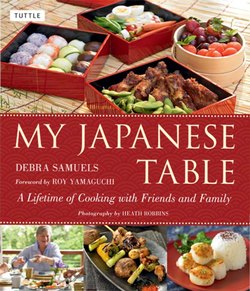Читать книгу My Japanese Table - Debra Samuels - Страница 10
На сайте Литреса книга снята с продажи.
ОглавлениеUseful Equipment
Bamboo Rolling Mat (Makisu) This mat is used for making sushi rolls. There are two types of mats. The one with cylindrical sticks bound together by string woven through the mat vertically. This is the most common and used with roasted seaweed, rice, and fillings to make a variety of rolls. It is covered in plastic wrap to make inside out rolls where the rice is on the outside and the seaweed is rolled inside the rice. The other mat is flat on one side and round on the other. This mat is used for both maki rolls and for shaping the Seasoned Rolled Omelet (Tamago Yaki) (p.34).
Chopstick Rests (Hashi Oki) Chopstick rests hold the tips of the chopsticks that diners place in their mouth when not in use. The rests can be made of porcelain, clay, wood, treated Japanese paper or even a natural stone (washed of course). The rests come in all different shapes and colors and generally complement the season and food. They can be fun, fanciful, or elegant (At a pub I saw one made with a screw and two bolts). Mine do double duty as knife or dessert fork rests.
Cooking Chopsticks (Saibashi) Cooking chopsticks come in lengths from 12 inches to 18 inches (30 cm-45 cm) and can be made of bamboo or metal. They keep fingers away from hot sauce and oil while turning or plucking food from pots. There are also cooking chopsticks with particularly narrow tips that are useful in garnishing a dish and special serving chopsticks with flat surfaces.
Drop Lids (Otoshibuta) These wooden lids are made to fit inside pots and rest directly on top of cooking food. The lid keeps the sauce from evaporating and concentrates it directly into the food. You can use parchment paper circles to achieve similar results.
Graters and Peeler (Oroshiki) Graters are used frequently in the preparation of Japanese food and for accompaniments for dishes. Graters do different jobs and can be made of metal, porcelain, and plastic. All have very sharp raised teeth that efficiently grate ginger, daikon radish, wasabi, onions, and other food. The two part graters that set a plastic grater atop a box are very useful as the grated food falls directly into the box. Substitute microplane graters and box graters to obtain desired texture.
Rice Cooker (Suihanki) The electric rice cooker is probably the most common item in Japanese kitchens and increasingly in western kitchens as well. They range from simple to sophisticated with sensors that have timers for soaking and automatic switch on. Many include a multitude of settings for cooking brown rice, porridge and sushi rice. All of them keep the rice warm. Rice cookers come with special 1 cup rice (1 ichi go) measures that are about 3/4 cup (160 g). These cookers also cook terrific takikomi gohan (rice cooked with a variety of ingredients).
Japanese Mortar and Pestle (Suribachi and Surikogi) Clay bowls with an unglazed grooved surface interior and a wooden stick are primarily used for grinding toasted sesame seeds and making pastes. When the toasted seeds are ground in a circular motion a nutty appetizing aroma is released from the seeds. The crushed seeds are used in sauces and as a tasty garnish. The bowls are also made in plastic, but the grinding stick remains wood.
